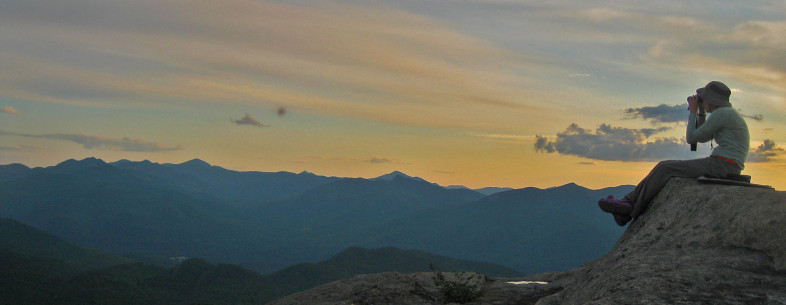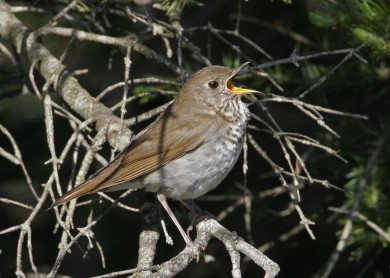It takes more than natural disasters to keep Mountain Birdwatch volunteers from their appointed rounds. Trees fall over trails. Bridges wash out. Gullies form and block routes. In 2011, Tropical Storm Irene rendered many sites unreachable. They’re all trivial compared to escaped convicts.
One Mountain Birdwatch route was abandoned this year because it fell within the search area for the notorious escaped prisoners in northern New York. And one volunteer needed an extension on submitting his data because duty called him to participate in the search for the escapees. (He still managed to complete his survey.)
So it goes on the Mountain Birdwatch trail. Escaped murderers aside, our volunteers overcame some huge obstacles (not including the mountains) to complete another season monitoring for Bicknell’s Thrush and other montane songbirds. More than 100 volunteers surveyed 105 of our 128 Mountain Birdwatch sites this year.
Although each and every volunteer deserves praise and VCE’s gratitude, we offer a particular shout out this year to Mike Zimmerman, as well as Brendan Collins, Grace Mitchum, and Isobel Curtis, who each completed extra routes on short notice when other volunteers needed to drop their routes due to illness, injury, work schedules, weather, or innumerable other — and completely valid — reasons. Even the New York Department of Environmental Conservation stepped in when a dozen routes in the Catskills lacked coverage. NY DEC techs covered all of these routes for us, ably coordinated by Jenny Murtaugh and Angie Ross in their office.
We’d like to offer particular thanks to Melissa MacKenzie, VCE’s business manager. When Mountain Birdwatch Director Judith Scarl left VCE in early June for greener pastures in Washington, D.C., Melissa stepped in and coordinated volunteers and data management seamlessly. Thanks, Melis!
We always like good wildlife stories from the mountains. This year, Alex Koch awoke to hear a soft, huffing noise just outside his tent. When Alex unzipped his tent to investigate, the moon illuminated a large, female moose contentedly licking his car. Moose “slobber” covered the car’s driver’s side window and windshield the next morning.
Mountain Birdwatch is a massive citizen-science project that provides the only region-wide source of population information on high-elevation breeding birds in the Northeast. So as we compile another year’s set of data (get those data sheets in, by the way), we are excited to announce that just last week, VCE was awarded a two-year grant from the National Fish and Wildlife Foundation that will support the analysis of Mountain Birdwatch data to generate the first spatially-explicit population estimates of Bicknell’s Thrush ever made, and to evaluate progress made toward important conservation goals for the Bicknell’s Thrush that are outlined in the Bicknell’s Thrush Conservation Action Plan of 2010.
We’ll apply those population size and distribution estimates to models of climate and landscape change, in order to predict how the Bicknell’s Thrush might respond under various climate and land use change scenarios. All of this will inform the Endangered Species status review for the Bicknell’s Thrush, which will be completed by the U.S. Fish and Wildlife Service in 2017.
Scientific rationale for critical habitat designations, prioritization for land protection, and information to mitigate effects on the Bicknell’s Thrush of infrastructure siting on ridgelines — real conservation, powered by volunteer-generated data. That’s citizen science at its best. And for that we thank you all!


